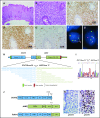Recurrent STAT3-JAK2 fusions in indolent T-cell lymphoproliferative disorder of the gastrointestinal tract
- PMID: 29592893
- PMCID: PMC5958657
- DOI: 10.1182/blood-2018-01-830968
Recurrent STAT3-JAK2 fusions in indolent T-cell lymphoproliferative disorder of the gastrointestinal tract
Conflict of interest statement
Conflict-of-interest disclosure: The authors declare no competing financial interests.
Figures

Similar articles
-
Targetability of STAT3-JAK2 fusions: implications for T-cell lymphoproliferative disorders of the gastrointestinal tract.Leukemia. 2020 May;34(5):1467-1471. doi: 10.1038/s41375-019-0678-3. Epub 2019 Dec 13. Leukemia. 2020. PMID: 31836854 Free PMC article. No abstract available.
-
Indolent T-cell lymphoproliferative disease of the gastrointestinal tract.Blood. 2013 Nov 21;122(22):3599-606. doi: 10.1182/blood-2013-07-512830. Epub 2013 Sep 5. Blood. 2013. PMID: 24009234 Free PMC article.
-
T-cell lymphoproliferative disorder with a STAT3 mutation causing a lymphocytic variant of hypereosinophilic-like syndrome without eosinophilia.J Hematop. 2025 Feb 15;18(1):6. doi: 10.1007/s12308-025-00621-1. J Hematop. 2025. PMID: 39954180
-
Update on lymphoproliferative disorders of the gastrointestinal tract: disease spectrum from indolent lymphoproliferations to aggressive lymphomas.Virchows Arch. 2020 May;476(5):667-681. doi: 10.1007/s00428-019-02704-8. Epub 2019 Nov 26. Virchows Arch. 2020. PMID: 31773249 Review.
-
Indolent T- and NK-cell lymphoproliferative disorders of the gastrointestinal tract: a review and update.Hematol Oncol. 2017 Mar;35(1):3-16. doi: 10.1002/hon.2317. Epub 2016 Jun 29. Hematol Oncol. 2017. PMID: 27353398 Review.
Cited by
-
Indolent T-Cell Lymphoproliferative Disease of the GI Tract: Insights for Better Diagnosis, Prognosis, and Appropriate Therapy.Front Oncol. 2020 Aug 7;10:1276. doi: 10.3389/fonc.2020.01276. eCollection 2020. Front Oncol. 2020. PMID: 32850389 Free PMC article. Review.
-
Update on the classification of T-cell lymphomas, Hodgkin lymphomas, and histiocytic/dendritic cell neoplasms.Expert Rev Hematol. 2019 Oct;12(10):833-843. doi: 10.1080/17474086.2019.1647777. Epub 2019 Jul 31. Expert Rev Hematol. 2019. PMID: 31365276 Free PMC article. Review.
-
CD8-positive indolent T-Cell lymphoproliferative disorder of the gastrointestinal tract: A case report and review of literature.World J Clin Cases. 2022 May 26;10(15):4971-4984. doi: 10.12998/wjcc.v10.i15.4971. World J Clin Cases. 2022. PMID: 35801019 Free PMC article.
-
Indolent T cell lymphoproliferative disorder with villous atrophy in small intestine diagnosed by single-balloon enteroscopy.Clin J Gastroenterol. 2019 Oct;12(5):434-440. doi: 10.1007/s12328-019-00971-1. Epub 2019 Apr 9. Clin J Gastroenterol. 2019. PMID: 30968266 Free PMC article.
-
Primary cutaneous gamma/delta T-cell lymphoma with simultaneous JAK2 and TP63 rearrangements: a new double-hit?Histopathology. 2023 Sep;83(3):492-495. doi: 10.1111/his.14973. Epub 2023 Jun 12. Histopathology. 2023. PMID: 37308177 Free PMC article.
References
-
- Jaffe ES, Chott A, Ott G, et al. . Indolent T-cell lymphoproliferative disorder of the gastrointestinal tract. In: Swerdlow SH, Camp E, Harris NL, et al., eds. WHO Classification of Tumours of Haematopoietic and Lymphoid Tissues. Lyon, France: International Agency for Research on Cancer; 2017:379-380.
-
- Smith CA, Fan G. The saga of JAK2 mutations and translocations in hematologic disorders: pathogenesis, diagnostic and therapeutic prospects, and revised World Health Organization diagnostic criteria for myeloproliferative neoplasms. Hum Pathol. 2008;39(6):795-810. - PubMed
-
- Lacronique V, Boureux A, Valle VD, et al. . A TEL-JAK2 fusion protein with constitutive kinase activity in human leukemia. Science. 1997;278(5341):1309-1312. - PubMed
Publication types
MeSH terms
Substances
Grants and funding
LinkOut - more resources
Full Text Sources
Other Literature Sources
Miscellaneous

